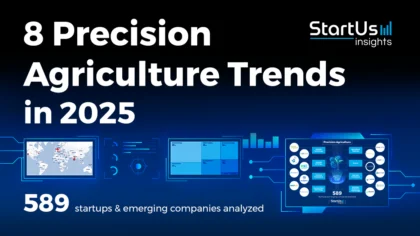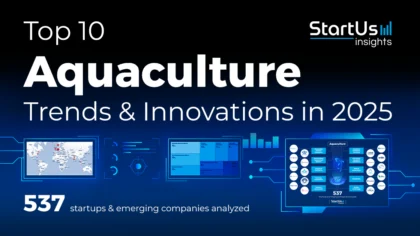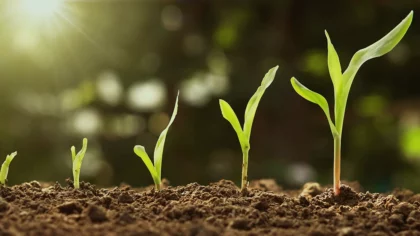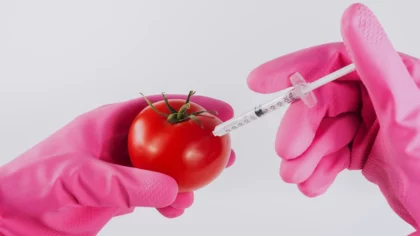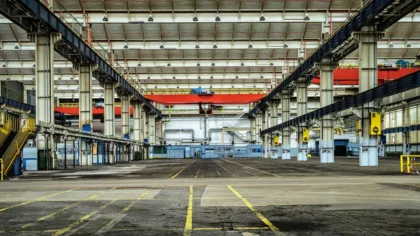Accelerate Productivity in 2025
Reignite Growth Despite the Global Slowdown
Technological advancements in agriculture allow farmers to meet the demands using cost-effective and efficient methods. Precision agriculture startups offer equipment and software solutions that help manage farming by monitoring, measuring, and responding to the variability of crops, livestock, and fields. This article highlights the top 8 global precision agriculture trends based on an analysis of 589 AgriTech startups and scaleups. These trends enable farmers to gather real-time data on crop fields, thereby improving product quality and overall farm management.
This article was last updated in July 2024.
Innovation Map outlines the Top Precision Agriculture Trends & 16 Promising Startups
For this in-depth research on the top global precision agriculture trends and startups, we analyzed a sample of 589 global startups & scaleups. This data-driven research provides innovation intelligence that helps you improve strategic decision-making by giving you an overview of emerging technologies and trends in the agriculture industry. In the Precision Agriculture Innovation Map, you get a comprehensive overview of the innovation trends & startups that impact your company.
Top 8 Precision Agriculture Trends (2025)
- Satellite Technology
- Internet of Things (IoT)
- Artificial Intelligence (AI)
- Variable Rate Technology (VRT)
- Agricultural Robotics
- Drones
- Big Data & Analytics
- Emission Reduction Technology

Want to explore all Precision Agriculture innovations & trends?
These insights are derived by working with our Big Data & Artificial Intelligence-powered StartUs Insights Discovery Platform, covering 4.7M+ startups & scaleups globally. As the world’s largest resource for data on emerging companies, the SaaS platform enables you to identify relevant technologies and industry trends quickly & exhaustively.
Tree Map reveals the Impact of the Top Precision Agriculture Trends
Based on the Precision Agriculture Innovation Map, the Tree Map below illustrates the impact of the Top 8 Precision Agriculture Technology Trends. Startups and scaleups are developing satellite technology solutions powered by Global Positioning Systems (GPS) tracking and global information systems (GIS) mapping methods to collect data in real time. Moreover, IoT solutions are in demand as data collection plays an essential role in boosting productivity and efficiency.
In addition, AI, variable rate technology, robotics, and drone solutions cover a large portion of this trend. Since site-specific management is an important topic of AgriTech, soil mapping through big data provides precise information about farmlands. Lastly, emission reduction technologies help farmers control carbon dioxide (CO2) emissions by processing large datasets.
Global Startup Heat Map covers Precision Agriculture Startups & Scaleups
The Global Startup Heat Map below highlights the global distribution of the 589 exemplary startups & scaleups that we analyzed for this research. Created through the StartUs Insights Discovery Platform, the Heat Map reveals high startup activity across India, Western Europe, and the USA.
Below, you get to meet 16 out of 500+ promising startups & scaleups as well as the solutions they develop. These precision agriculture startups are hand-picked based on criteria such as founding year, location, funding raised, & more. Depending on your specific needs, your top picks might look entirely different.
Top 8 Precision Technology Trends for 2025
1. Satellite Technology
Variability and quality of data are the main challenges preventing the further implementation of sustainable agriculture practices. Satellite technology in agriculture helps farmers analyze large areas of their farms in a short period of time and in real time.
Moreover, it allows farmers to react immediately to localized issues like fertilization and irrigation. Technologies such as GIS and GPS further enable farmers to determine the topography, heterogeneity, and yield estimation of crops, as well as for livestock tracking.
701x digitalizes Cattle Records
US-based startup 701x provides cattle tracking solutions for large-scale farms and ranches. 701x combines its precision agriculture software with its GPS ear tag. xTpro lets users keep track of animal activities, interactive alerts, and wellness information, among other features.
Additionally, the solar-powered ear tags limit user interaction while eliminating the need for battery changes. Moreover, the cellular connectivity of the ear tags allows automatic data transmission via cellular networks enabling real-time GPS position and animal traceability data.
Sensefarming provides GIS Mapping Solutions
Ukrainian startup Sensefarming enables field analysis utilizing Geographic Information Systems (GIS). The startup determines the current state of the soil while discovering issues and causes of deterioration in precision farming via its wide range of GIS solutions.
The analysis helps farmers identify yield potential, Vegetation Indices (VI), and use retrospective analysis to assess the dynamics of soil development. The solution also identifies the capability of the vegetation features and spectral indices using Digital Soil Mapping (DSM).
2. Internet of Things (IoT)
Data collection is becoming an integral part of the agricultural process. To decide which type of pesticides and fertilizers should be used for reaching optimal efficiency, monitoring weather conditions, taking control of production processes, and lowering production risks, farmers turn to IoT solutions.
The usage of IoT sensors, such as RFID chips, helps farmers optimize all aspects of their work, including crop farming and tracking cattle. Further, the live monitoring of the field data enables farmers to make the best decisions on upcoming production while reducing their environmental impact.
Agrila builds an IoT-based Sensor Station
Agrila, a Bulgarian startup, developed a modular IoT-based sensor station to monitor vital parameters such as soil moisture, temperature, wind speed, wind direction, rain, humidity, and solar irradiation.
Powered by solar energy, the station provides real-time alerts through mobile and web applications. Additionally, Agrila’s solution offers detailed charts, reports, and analyses of sensor data, allowing farmers to gain insights.
ESI SYSTEM specializes in Digital Sensors and Probes
Spanish startup ESI SYSTEM develops digital precision agriculture sensors and probes to protect and improve climatic conditions. Through the application of Climate and Anti-Frost Control systems, farmers receive ice formation and water condensation data on leaves and check the climate, temperature, and humidity levels.
Additionally, digital networks enable the users to observe live crop performance, and phenological development and allow them to implement pest control when combined with Smart Agro software. The implementation of digital sensors and probes allows the startup to access all the data remotely, which increases the efficiency and sustainability of the crops.
3. Artificial Intelligence (AI)
AI enhances the data collected from various sensors to enable precision agriculture and improve harvest quality and accuracy. AI also makes various other aspects of Agtech operations smarter. For example, water management and energy consumption are optimized with AI, which leads to much more accurate decisions taken by the farmers. Machine learning and deep learning techniques are becoming an integral part of agriculture and are utilized in soil and crop monitoring, and agricultural robotics, among others.
Sway AI develops Precision Agriculture Platform
US-based startup Sway AI develops a no-code AI platform for precision agriculture applications. Through machine learning models and aerial images, farmers utilize crop and soil health analysis. Additionally, the data is further analyzed on plant growth stage and yield to apply fertilizer and irrigation in a more targeted way.
The digital platform also leads to operational data analysis in order to highlight process inefficiencies and enhance farm management systems while increasing yields without using any extra resources.
Mojow develops Autonomous Navigation Kits
Canadian startup Mojow streamlines on-farm operations through the application of artificial intelligence to build a sustainable agriculture industry. They develop an autonomous navigation kit for agricultural power units called EYEBOX to perceive the local environment in real-time. The power unit is taking raw sensor data and creates different representations of the environment around the machine.
The startup uses deep learning so that the autonomous tractor can analyze and react in real-time within its working environments. Additionally, millions of data frames from a large variety of operations feed Mojow’s Data Engine for data-driven application development.
4. Variable Rate Technology (VRT)
One of the most reliable methods of boosting productivity is the application of variable rate technology in precision agriculture. VRT enables the application of water, nutrients, and other factors of production at varying rates across a field. This eliminates the need to make multiple runs across an area or constantly change rate settings on machinery.
Moreover, VRT eliminates the time-consuming agricultural tasks that are done manually while also reducing the chance of human error. Hence, VRT helps farmers boost productivity, increase precision and improve risk management. Some examples of VRT include fertigation systems, precision pest management, and variable rate application. Precision sprayers and many more.
BBLeap offers Precision Spraying Solutions
Dutch startup BBLeap produces a precision sprayer system called LeapBox. It is a modular system where the hardware is tailored to the technical features, sprayer models, boom specs, and type. LeapBox regulates the application rate based on a fixed pressure, ensuring that the optimal droplet size is always maintained.
Through the application of LeapBox, better growth on crops is achieved by only spraying where and when it is needed. Moreover, farmers maintain zero-compromise spraying quality at low and high driving speeds thanks to the high switching speed of the valves which provide step-less rate regulation for each nozzle from 2% to 98%.
GeoPard Agriculture specializes in Variable Rate Application Maps
German startup GeoPard Agriculture develops Management Zones & VRA Maps for precision ag operations. The solution helps farmers streamline operations in crop farming, particularly, to create single and multi-layer analytics, field potential, and field stability maps.
The startup automatically creates zones that are based on agrochemical analysis, topography, and moisture data to help business owners plan for a better harvest. Moreover, its VRA Maps are compatible with already existing agritech machinery which could be seamlessly integrated into existing practices to make precision agriculture simple.
5. Agricultural Robotics
The increasing demand for food and shortage of labor affects agriculture in all aspects. Agricultural robots assist farmers in solving the above-mentioned challenges. Moreover, agricultural robots are capable of data gathering and analysis to increase crop yields. Additionally, technological advancements in robotics in agriculture allow farmers to assign robots to repetitive and time-consuming tasks.
Application of robotics in agriculture includes automated and assisted steering systems, mobile agricultural robot swarms (MARS), and mechanical swarms among others. Furthermore, robotics automation in agriculture decreases resource consumption and the chance of human error, leading to cost-efficient production and improved food quality.
Trabotyx manufactures Weed Control Robots
Dutch startup Trabotyx builds a weed control robot for crop fields. The single-row autonomous weeding robot covers 1 acre or more per day and automates the work of four people weeding manually. Consequently, it improves the efficiency of farming operations by reducing dependence on outside labor, continuous operation, and significant cost reduction on weed control.
Moreover, the robot’s wheelbase is modular to fit on any field layout, and the application of multiple weeding implements allows farmers to weed precisely. Additionally, remote support provided by the startup allows them to take control of the robot in case of any problems which reduces the number of checks on a working robot.
AuRos Robotics develops Automated Harvesting Solutions
Brazilian startup AuRos Robotics provides harvest automation solutions for fruit growers through the application of robotics. Together with computer vision and artificial intelligence technologies, production gets automated and optimized to farmers’ needs.
The main benefits of the technology include harvesting at the most ideal period of time and verification of the quality of fruits, among others. The robot also automatically pre-classifies the produce according to its size, type, or degree of ripeness during harvesting.
6. Drones
Plant health monitoring, pest control, livestock management, aerial survey, and soil analysis are increasingly performed by drones. Unmanned aerial vehicles (UAV), and unmanned ground vehicles (UGV) are utilized in agricultural production to boost the efficiency and quality of products.
Moreover, drones are less prone to human errors and require minimal observation. Further, in conjunction with satellite imagery, drone imagining is incorporated to gain a better understanding of the field potential and soil quality.
ANTPOD produces Unmanned Ground and Aerial Surveillance Vehicles
Indian startup ANTPOD offers services for chemical application and field surveillance for large holding farmers and corporations, utilizing unmanned technologies to improve efficiency. The startup enables farmers to optimize path planning and navigation and locate the problem areas on farms and fields.
In particular, it integrates the nuances of telemetric analysis, machine learning, and image processing in order to provide optimized agricultural solutions to possible emerging problems. Moreover, integrated monitoring networks through unmanned ground and aerial surveillance can cover 1 ha of land in under 4 hours, saving time and potentially lowering resource costs.
X – ENDER develops Autonomous Agricultural Tractors
Italian startup X – ENDER develops an autonomous modular truck called OX. The main feature of OX is having autonomy on mission fulfillment which leads to time-efficient ag operations. Moreover, the implemented learning optimization system helps it to increase efficiency through experience in the field.
The autonomous truck is also compatible with standard agricultural machines and logistic containers which eliminates the need for any other upgrades in already existing farming equipment.
7. Big Data & Analytics
Big data & analytics enable farmers to make the right decisions that ultimately improve farm yields. Software solutions provide site- and production-specific insights on rainfall patterns, fertilizer requirements, water cycles, and more. Further, the implementation of big data and analytics makes agricultural production more proficient, productive and well-regulated while preserving the environment and climate.
Data analytics also assist farmers in real-time plant health monitoring, actionable insights for upcoming yields, and resource management decisions based on established trends. Furthermore, the digitalization of farming reduces labor-related costs while improving efficiency and providing fast and reliable solutions for upcoming production issues.
Palmear develops Pest Control Device
UAE-based startup Palmear manufactures a device that uses artificial intelligence, audio engineering, and big data to solve major challenges affecting the early detection of pests. Palmear is based on highly sensitive acoustic technology that detects and senses the slightest movement of larvae inside trees or beneath the soil.
Besides detection, the device helps farmers by providing additional data on localizing pest infestation, optimizing the usage of pesticides and chemicals, and monitoring infestations and treatment processes. Moreover, exact location detection of pest infestation allows farmers to enable the targeted use of chemicals and pesticides.
VAIS develops Virtual Field Probing solutions
Egyptian startup VAIS provides Virtual Field Probing (VFP) solutions for precision agriculture. It addresses many of agricultural limitations and offers a low-cost, easy-to-deploy, and scalable monitoring solution that provides high temporal and spatial resolution data for farmers. VFP is a satellite-enabled sensing technology that applies deep learning models to massive amounts of complex, raw data to make reliable predictions.
8. Emission Reduction Technology
Inefficient agricultural activities that increase greenhouse gas (GHG) emissions challenge the agricultural industry more than ever. In this regard, digital technologies in farming reduce emissions through the implementation of carbon capture, utilization, and storage solutions.
In addition, carbon sequestration maps and data analysis platforms have the potential to reduce agricultural inputs by implementing site-specific applications. Emission reduction in agriculture enables farmers to better target inputs to the spatial needs of the fields which results in lower greenhouse gas emissions.
SmartCloudFarming offers 3D Mapping Solutions
German startup SmartCloudFarming provides 3D Organic Soil Carbon Maps for farmers. The remote and scalable solution enables farmers to measure their fields’ current and historical soil organic carbon levels. Moreover, it determines how much soil carbon the farmland sequestered and how much it increased compared to the previous years.
Additionally, 3D maps are based on the output measure of the first 30 cm of soil, therefore, it gives detailed information regarding the carbon stock up through soil organic carbon and bulk density measuring.
Downforce Technologies provides Digital Twin Platform Services
UK-based startup Downforce Technologies creates a digital twin of lands and farms to accurately measure the value of natural capital and ecosystems. The platform is applicable to all kinds of soil and provides insights with over 90% accuracy.
The platform also provides insights regarding climate resilience and carbon sequestration. In particular, farmers use the data to efficiently manage soil carbon capture initiatives and biodiversity conservation, in turn, improving the resilience of their land.
Discover all Precision Agriculture Trends, Technologies & Startups
The top 8 precision farming technology trends bring innovative solutions to the agriculture sector to improve productivity, sustainability, and efficiency. The development of satellite and 3D mapping solutions revolutionizes agriculture by making farmers react as quickly as possible to possible negative changes in farms and cattle.
At the same time, environmental protection is becoming a priority for them while using emission reduction solutions for limiting carbon emissions into the atmosphere, while also improving the quality of the soil.
The Precision Agriculture Trends & Startups outlined in this report only scratch the surface of trends that we identified during our data-driven innovation & startup scouting process. Among others, emissions reduction, soil remediation, & field analytics solutions will transform the sector and shape the future trends in precision agriculture.
Identifying new opportunities & emerging technologies to implement into your business goes a long way in gaining a competitive advantage. Get in touch to easily & exhaustively scout startups, technologies & trends that matter to you!

